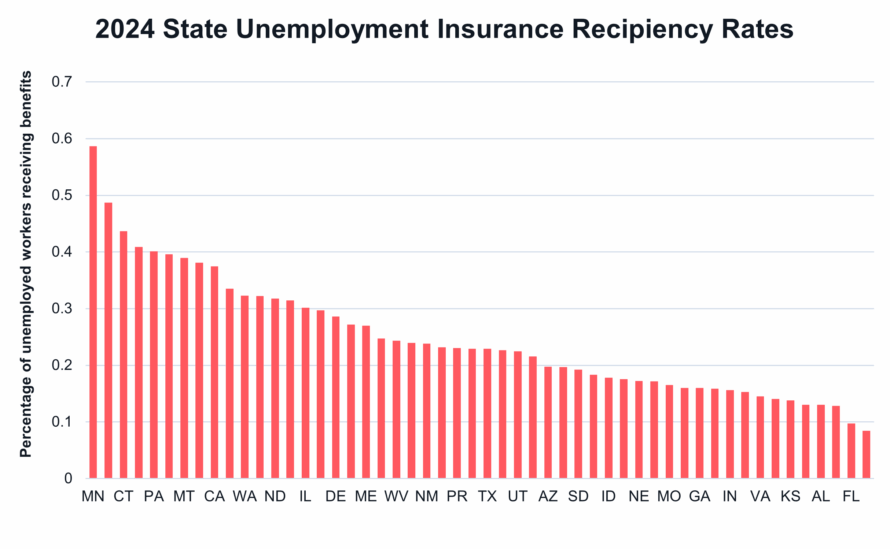Summary
After job loss, all workers should be able to sustain themselves while they seek new work. Unemployment insurance (UI) is the principal program designed to support jobless workers in the United States, and it not only assists workers and their families but also stabilizes the overall economy and promotes resilience and recovery during economic downturns. In a time of economic uncertainty, maintaining a strong UI system should be priority for policymakers.
But in 2024, only 27 percent of unemployed workers nationwide received UI benefits,[i] leaving more than 73 percent of jobless workers without support and undermining the UI system’s ability to mitigate an economic crisis. This brief looks at how states and the federal government can increase the proportion of unemployed workers who receive UI benefits, highlighting seven proven policies that help jobless workers apply for and receive the benefits they have earned.
The Share of Unemployed Workers that Receive Benefits Varies by State
Unemployment insurance is a joint-state and federal program: States have broad latitude to administer the program, determine benefit levels, set maximum duration, decide which workers are eligible, and finance benefits. As a result, state UI programs vary widely. There are especially large differences between states in terms of the proportion of unemployed workers who receive UI benefits (known as the recipiency rate). As figure 1 shows, fewer than 9 percent of unemployed workers in Kentucky (the state with the lowest recipiency rate) received UI benefits in 2024, compared to nearly 59 percent of unemployed workers in Minnesota (the highest
recipiency state).

Source: US Department of Labor Employment and Training Administration Unemployment Insurance Chartbook
Our analysis finds that if every state in the U.S. had the same recipiency rate as Minnesota in 2024, an additional 2.4 million jobless workers would have received support from UI benefits that year.[ii]
This brief builds on NELP’s previous research examining the factors that determine UI recipiency rates, the significant barriers to access, and why eligible workers often don’t apply for UI benefits. We proposed a set of federal performance standards, including a target rate of 50 percent of unemployed workers receiving UI benefits. Now we ask how states can achieve this goal, and how the federal government can best support them.
Key Points
- Unemployment insurance (UI) supports jobless workers and their families and stabilizes the economy during downturns.
- In 2024, just 27 percent of unemployed workers received UI benefits, undermining the UI system’s ability to mitigate an economic crisis.
Key Solutions
To increase the share of unemployed workers who receive UI benefits, states should:
- Guarantee enough weeks of UI benefits
- Ensure benefits replace an adequate share of workers’ prior wages
- Expand UI eligibility
- Provide community support and outreach
- Reduce administrative burdens
- Require employers to provide better information about applying for UI benefits
- Change employer incentives
The federal government can and should support states in pursuing these solutions.
Endnotes
[i] U.S. Department of Labor Employment and Training Administration, Unemployment Insurance Chartbook, Recipiency Rates, by State, https://oui.doleta.gov/unemploy/chartbook.asp.
[ii] NELP analysis based on U.S. Department of Labor, Unemployment Insurance Data, https://oui.doleta.gov/unemploy/data_summary/DataSum.asp.
Related to
Related Resources
All resourcesNELP’s New York City Worker Justice Agenda

Policy & Data Brief
Why Lawmakers Must Remove the Labor Dispute Disqualification from Unemployment Insurance

Policy & Data Brief
Workers Denied: How to Diagnose and Prevent Improper Unemployment Insurance Denials

Policy & Data Brief
